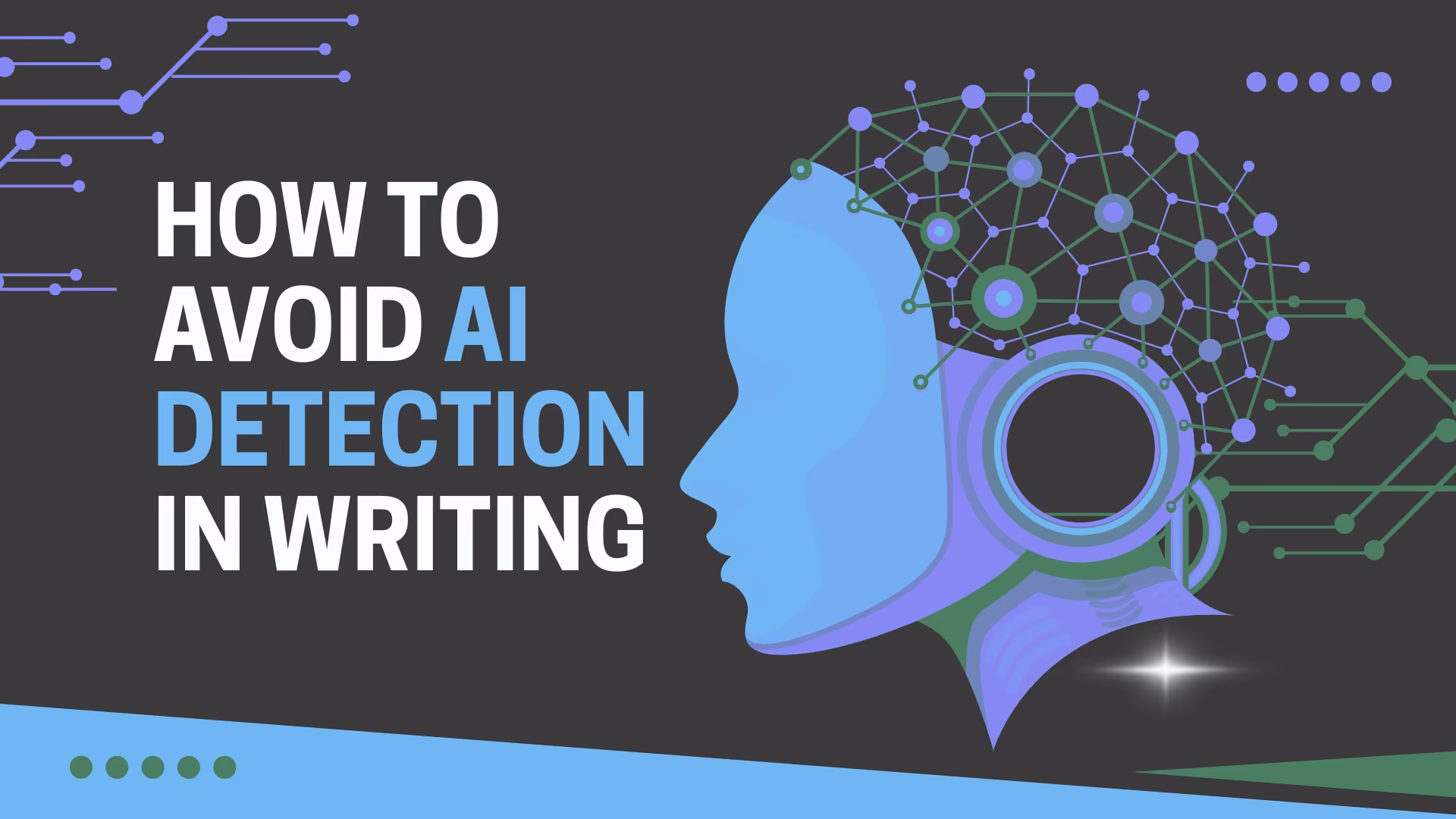If you’re reading this, it’s probably because you’ve come across an issue in the content creation world that’s becoming more common—AI detection. As powerful as AI writing tools like ChatGPT, Jasper, and others are, they’re often flagged by AI detection tools. Whether you’re a content creator, blogger, marketer, or student, understanding how to avoid AI detection in your writing is a crucial skill to have.
The good news? It’s entirely possible to generate content with AI while making it sound completely human. And we’re here to show you exactly how to do that!
This step-by-step guide will walk you through the process of creating AI-generated content that evades AI detection, from sentence structure tweaks to personalized writing techniques. By the end of this, you’ll know how to humanize your writing in ways that will keep your content looking fresh, authentic, and undetectable by even the most advanced AI detectors.
What Is AI Detection?
Before we jump into the how-to's, let’s clarify what AI detection actually means.
AI detection refers to the practice of identifying whether a piece of content has been created by an AI tool or a human. It sounds a bit technical, but think of it like this: AI detectors are digital detectives, sniffing out patterns and signs in your writing that hint at its artificial origin.
How do they do this? Well, AI detectors analyze your content for certain characteristics such as:
- Repetitive patterns: AI tends to reuse certain sentence structures or words, which makes its writing feel robotic.
- Unusual phrasing or syntax: The way AI strings sentences together can be very predictable and unnatural.
- Lack of personal touch: AI doesn’t have emotions or experiences, so its writing often lacks the depth that comes from personal storytelling.
AI detection tools, such as Surfer AI, Grammarly, and Originality.AI, use algorithms trained on tons of text to look for these markers. They examine everything from the structure of your sentences to the uniqueness of your word choices.
Why Does AI Detection Matter?
Why should we care about AI detection? Simple—it affects everything from SEO to audience trust.
- SEO and Search Engine Ranking: Search engines, especially Google, are getting better at distinguishing between content written by humans and content written by AI. Google’s algorithms focus on user experience, and AI-generated content that lacks a personal, human touch may get flagged. Flagged content = potentially lower ranking.
- Reader Trust: As readers become more aware of AI-generated content, they may start to question the authenticity of what they’re reading. AI can write well, but it doesn’t have the personal insights, experiences, or emotions that human writers do. Without that, your content might feel flat or disengaging.
- Content Quality: While AI is great for brainstorming and drafting, it often lacks the finesse, depth, and creativity that human writers bring to the table. Detected AI content could be seen as “less valuable” because it may lack that authentic, human essence.
So, in short: AI detection matters because it affects how your content performs, how it’s received, and how you’re perceived—both by search engines and by your audience.
How to Avoid AI Detection in Your Writing: 10 Simple, Effective Strategies
Now that we understand AI detection, let’s dive into the good stuff. Here are 10 proven strategies to make sure your AI-generated content passes the AI detection test with flying colors.

10 ways to humanize ai writing
1. Rephrase Sentence Structure
One of the quickest and easiest ways to avoid AI detection is to restructure your sentences. AI-generated content tends to follow predictable patterns, especially in sentence length and structure. If you shuffle the order of your sentences or change the phrasing slightly, you can throw off the AI detection tools.
Example:AI-generated: "The moon rose slowly, casting a pale light over the ocean."Rephrased: "As the moon rose, its pale light washed over the ocean."
Notice the difference? The second sentence has the same meaning but feels less robotic and more human. Changing sentence structures in this way makes it harder for AI detectors to flag your content.
2. Use Synonyms and Alternative Words
AI content often overuses common words and phrases, which can make it easier for detection tools to spot. By replacing some of those terms with synonyms, you can avoid detection without losing the meaning of your content.
Example: Instead of saying, “AI content is essential for digital marketing,” try: “AI writing tools are crucial for modern marketing strategies.”
Both sentences have the same meaning, but the second one feels fresher and avoids overused phrases. Small changes like these can make a big difference.
3. Incorporate Personal Anecdotes
AI lacks personal experiences or stories. Humans, on the other hand, love telling stories. By weaving in personal anecdotes, real-life examples, or experiences, you can make your content feel more authentic and relatable.
Example: “I remember when I first started using AI for content creation. I was skeptical at first, but soon realized how much time I could save.”
This personal touch adds warmth and personality to your writing, which AI can’t replicate. It also makes it more difficult for AI detection tools to flag your content.
4. Use an Anti-AI Detection Tool (Text Humanizer)
Here’s where Humanize AI Text comes into play. This tool is designed specifically to tweak AI-generated content so that it sounds more human. It removes robotic-sounding phrases, adjusts sentence structures, and adds a conversational flow to your writing.
By running your AI-generated content through a text humanizer, you can ensure that it bypasses detection tools while maintaining readability and engagement. Humanize AI Text is a great solution for anyone looking to make their AI writing undetectable.
You can check it out here: Humanize AI Text.
5. Avoid Repetitive Keywords and Phrases
AI-generated content tends to be repetitive. Whether it’s overusing certain phrases or rehashing the same ideas, AI can easily fall into this trap. The more repetitive the content, the more likely it is to get flagged by AI detection tools.
To avoid this, mix it up. Use varied vocabulary and rephrase sentences to keep things fresh and engaging. AI detectors love to spot patterns—so breaking them is key.
6. Vary Sentence Length and Structure
AI often creates content with a predictable rhythm, using sentences that are roughly the same length. Humans, however, naturally vary sentence length for emphasis and flow. By mixing up short, punchy sentences with longer, more detailed ones, you can create a more dynamic piece of writing.
For example, start with a simple sentence for impact: “The AI revolution is here.”
Then follow up with a longer sentence for detail: “This technology is transforming industries, from healthcare to finance, and is making waves in how we think about content creation and automation.”
This contrast in sentence length makes the writing feel more natural and less robotic.
7. Write in Active Voice
AI-generated content often uses passive voice, which can make it sound more distant and less engaging. By using active voice, you make the content more direct, personal, and engaging.
Example: Passive: "The data was analyzed by the team." Active: "The team analyzed the data."
The active voice sounds more natural and is the preferred style for human writing.
8. Inject Humor or Emotion
AI writing can feel a bit flat because it often lacks emotion or personality. Humans, on the other hand, are great at using humor, empathy, and other emotional triggers in writing. By incorporating these elements, you can make your content sound much more human.
Example: Instead of saying, "Our product is effective," try: "Our product actually works—and no, it’s not magic, just great engineering."
This humorous and light-hearted approach makes the content feel more personal and engaging.
9. Use Descriptive and Specific Prompts
AI often generates content that’s vague or generic because its prompts are too broad. To get more specific, use detailed, descriptive prompts that encourage the AI to write more vivid, engaging content.
For example, instead of asking AI to “write about a beach,” try: “Describe a beach at sunrise, with the sound of the waves crashing, the smell of salt in the air, and the warmth of the sun rising over the horizon.”
This will give you more colorful, engaging content that feels human.
10. Edit, Edit, Edit
Finally, don’t forget the editing phase. Even if your AI-generated content looks great at first, it’s important to go through it with a fine-tooth comb. Look for places where the writing feels too mechanical, repetitive, or awkward.
Tip: Read the content out loud. If it doesn’t sound like something a human would say, it probably needs tweaking. Editing helps you add your personal touch and refine the content to make it pass undetected.
How Humanize AI Text Can Help You
I know, I know—by now, you’re probably wondering how you can make this process even easier. That’s where Humanize AI Text comes into play. This tool helps take AI-generated content and humanizes it in just a few clicks.
By using Humanize AI Text, you can transform your content into something that reads naturally, without spending hours editing. The best part? It’s undetectable by AI content detectors.
Here’s how it works:
- You paste your AI-generated content into the tool.
- The tool scans for common AI writing patterns.
- It tweaks the language, structure, and tone to make it sound more like a human wrote it.
- You get back a polished, engaging piece of writing ready to be published.

Faster, better content by ai humanize
It’s that simple. Humanize AI Text makes AI-generated content feel genuine, relatable, and, most importantly, undetectable.
Check it out for yourself: Humanize AI Text.
Bypass AI Detection with Human-Like Content
At the end of the day, the best content is a blend of AI efficiency and human creativity. By using AI tools to draft your content and humanizing them with the tips and tools provided in this guide, you can create undetectable, high-quality content that resonates with readers and search engines alike.
Remember, the goal is not to deceive, but to enhance your content in a way that feels natural, authentic, and engaging. By following these 10 steps, you’ll not only avoid AI detection but also improve the quality of your content, making it more relatable and enjoyable for your audience.
Want to take your AI-generated content to the next level? Visit Humanize AI Text and start creating human-like content that’s undetectable today!
Frequently Asked Questions
1. What are AI detectors looking for?
AI detectors look for patterns such as repetitive phrases, overly formal language, and awkward sentence structures that are typical of AI writing. They analyze these elements to determine whether the content was generated by a machine or a human.
2. Can AI-generated content rank on Google?
Yes, AI-generated content can rank on Google, as long as it’s high-quality and useful. Google focuses more on the value and user experience of the content rather than how it was created. But if it sounds robotic or unnatural, it may get penalized.
3. How do I know if my content has been flagged as AI-generated?
To check if your content has been flagged, use AI detection tools like Surfer AI, Grammarly, or Originality.AI. These tools analyze your text for AI markers and provide you with a report.
4. Is it ethical to use AI-generated content?
Using AI to create content is perfectly ethical as long as it adds value to your audience. Transparency is key—if you’re using AI, make it clear to your readers. Avoid misleading them into thinking that the content is solely human-written if it’s not.
5. How can I make sure my AI-generated content sounds more human?
To make AI-generated content sound more human, use techniques like rephrasing sentence structures, avoiding repetition, adding personal anecdotes, and using Humanize AI Text to polish your content and make it more engaging.


